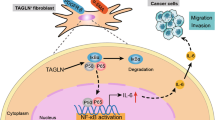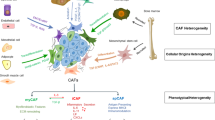Abstract
Tumor growth is influenced by interactions between malignant cells and the tumor stroma. Although the normal host microenvironment is nonpermissive for neoplastic progression, tumor-reactive stroma, characterized by the presence of activated fibroblasts, promotes neoplastic growth and metastasis. Secreted protein, acidic and rich in cysteine (SPARC) is a matricellular glycoprotein that is capable of inhibiting the growth of several different types of cancer. Recently, we reported that SPARC also impairs the growth of xenografts comprised of 293 cells. In this study, we show that in addition to enhancing stroma formation, SPARC prevents fibroblast activation in 293 xenografts, suggesting that the anti-cancer effects of SPARC may be due, at least in part, to the formation of tumor stroma that is not supportive of tumor growth. In vitro, 3T3 fibroblasts cocultured with SPARC-transfected 293 cells remain negative for α-smooth muscle actin, whereas wild-type 293 cells induce fibroblast activation. Moreover, activation of 3T3 cells and primary fibroblasts by transforming growth factor β is blocked by SPARC treatment. We also demonstrate that SPARC significantly increases basic fibroblast growth factor-induced fibroblast migration in vitro, indicating that it may recruit host fibroblasts to the tumor stroma. Taken together, our results suggest that in addition to blocking angiogenesis, SPARC may inhibit tumor growth by promoting the assembly of stroma that is non-permissive for tumor progression.
This is a preview of subscription content, access via your institution
Access options
Subscribe to this journal
Receive 50 print issues and online access
$259.00 per year
only $5.18 per issue
Buy this article
- Purchase on Springer Link
- Instant access to full article PDF
Prices may be subject to local taxes which are calculated during checkout






Similar content being viewed by others
References
Arrick BA, Lopez AR, Elfman F, Ebner R, Damsky CH, Derynck R . (1992). Altered metabolic and adhesive properties and increased tumorigenesis associated with increased expression of transforming growth factor beta 1. J Cell Biol 118: 715–726.
Barker TH, Baneyx G, Cardo-Vila M, Workman GA, Weaver M, Menon PM et al. (2005). SPARC regulates extracellular matrix organization through its modulation of integrin-linked kinase activity. J Biol Chem 280: 36483–36493.
Beacham DA, Cukierman E . (2005). Stromagenesis: the changing face of fibroblastic microenvironments during tumor progression. Semin Cancer Biol 15: 329–341.
Bradshaw AD, Sage EH . (2001). SPARC, a matricellular protein that functions in cellular differentiation and tissue response to injury. J Clin Invest 107: 1049–1054.
Brekken RA, Puolakkainen P, Graves DC, Workman G, Lubkin SR, Sage EH . (2003). Enhanced growth of tumors in SPARC null mice is associated with changes in the ECM. J Clin Invest 111: 487–495.
Chlenski A, Liu S, Crawford SE, Volpert OV, DeVries GH, Evangelista A et al. (2002). SPARC is a key Schwannian-derived inhibitor controlling neuroblastoma tumor angiogenesis. Cancer Res 62: 7357–7363.
Chlenski A, Liu S, Guerrero LJ, Yang Q, Tian Y, Salwen HR et al. (2006). SPARC expression is associated with impaired tumor growth, inhibited angiogenesis and changes in the extracellular matrix. Int J Cancer 118: 310–316.
Desmouliere A, Geinoz A, Gabbiani F, Gabbiani G . (1993). Transforming growth factor-beta 1 induces alpha-smooth muscle actin expression in granulation tissue myofibroblasts and in quiescent and growing cultured fibroblasts. J Cell Biol 122: 103–111.
Framson PE, Sage EH . (2004). SPARC and tumor growth: where the seed meets the soil? J Cell Biochem 92: 679–690.
Francki A, McClure TD, Brekken RA, Motamed K, Murri C, Wang T et al. (2004). SPARC regulates TGF-beta1-dependent signaling in primary glomerular mesangial cells. J Cell Biochem 91: 915–925.
Funk SE, Sage EH . (1991). The Ca2(+)-binding glycoprotein SPARC modulates cell cycle progression in bovine aortic endothelial cells. Proc Natl Acad Sci USA 88: 2648–2652.
Funk SE, Sage EH . (1993). Differential effects of SPARC and cationic SPARC peptides on DNA synthesis by endothelial cells and fibroblasts. J Cell Physiol 154: 53–63.
Gabbiani G, Ryan GB, Majne G . (1971). Presence of modified fibroblasts in granulation tissue and their possible role in wound contraction. Experientia 27: 549–550.
Hall A . (1998). Rho GTPases and the actin cytoskeleton. Science 279: 509–514.
Hamid T, Malik MT, Kakar SS . (2005). Ectopic expression of PTTG1/securin promotes tumorigenesis in human embryonic kidney cells. Mol Cancer 4: 3.
Kalluri R, Zeisberg M . (2006). Fibroblasts in cancer. Nat Rev Cancer 6: 392–401.
Liu S, Tian Y, Chlenski A, Yang Q, Zage P, Salwen HR et al. (2005). Cross-talk between schwann cells and neuroblasts influences the biology of neuroblastoma xenografts. Am J Pathol 166: 891–900.
Maeshima AM, Niki T, Maeshima A, Yamada T, Kondo H, Matsuno Y . (2002). Modified scar grade: a prognostic indicator in small peripheral lung adenocarcinoma. Cancer 95: 2546–2554.
Meyerhardt JA, Mayer RJ . (2005). Systemic therapy for colorectal cancer. N Engl J Med 352: 476–487.
Motamed K, Funk SE, Koyama H, Ross R, Raines EW, Sage EH . (2002). Inhibition of PDGF-stimulated and matrix-mediated proliferation of human vascular smooth muscle cells by SPARC is independent of changes in cell shape or cyclin-dependent kinase inhibitors. J Cell Biochem 84: 759–771.
Mueller MM, Fusenig NE . (2004). Friends or foes – bipolar effects of the tumour stroma in cancer. Nat Rev Cancer 4: 839–849.
Olumi AF, Grossfeld GD, Hayward SW, Carroll PR, Tlsty TD, Cunha GR . (1999). Carcinoma-associated fibroblasts direct tumor progression of initiated human prostatic epithelium. Cancer Res 59: 5002–5011.
Orimo A, Gupta PB, Sgroi DC, Arenzana-Seisdedos F, Delaunay T, Naeem R et al. (2005). Stromal fibroblasts present in invasive human breast carcinomas promote tumor growth and angiogenesis through elevated SDF-1/CXCL12 secretion. Cell 121: 335–348.
Paget S . (1889). The distribution of secondary growths in cancer of the breast. Lancet 1: 571–573.
Perdue N, Yan Q . (2006). Caveolin-1 is upregulated in transdifferentiated lens epithelial cells but minimal in normal human and murine lenses. Exp Eye Res 83: 1154–1161.
Pichler RH, Bassuk JA, Hugo C, Reed MJ, Eng E, Gordon KL et al. (1996). SPARC is expressed by mesangial cells in experimental mesangial proliferative nephritis and inhibits platelet-derived-growth-factor-medicated mesangial cell proliferation in vitro. Am J Pathol 148: 1153–1167.
Powell DW, Mifflin RC, Valentich JD, Crowe SE, Saada JI, West AB . (1999). Myofibroblasts. I. Paracrine cells important in health and disease. Am J Physiol 277: C1–C9.
Rosen ST, Gould VE, Salwen HR, Herst CV, Le Beau MM, Lee I et al. (1987). Establishment and characterization of a neuroendocrine skin carcinoma cell line. Lab Invest 56: 302–312.
Sage H, Johnson C, Bornstein P . (1984). Characterization of a novel serum albumin-binding glycoprotein secreted by endothelial cells in culture. J Biol Chem 259: 3993–4007.
Schiemann BJ, Neil JR, Schiemann WP . (2003). SPARC inhibits epithelial cell proliferation in part through stimulation of the transforming growth factor-β-signaling system. Mol Biol Cell 14: 3977–3988.
Skobe M, Rockwell P, Goldstein N, Vosseler S, Fusenig NE . (1997). Halting angiogenesis suppresses carcinoma cell invasion. Nat Med 3: 1222–1227.
Strutz F, Okada H, Lo CW, Danoff T, Carone RL, Tomaszewski JE et al. (1995). Identification and characterization of a fibroblast marker: FSP1. J Cell Biol 130: 393–405.
Wilkes MC, Mitchell H, Penheiter SG, Dore JJ, Suzuki K, Edens M et al. (2005). Transforming growth factor-beta activation of phosphatidylinositol 3-kinase is independent of Smad2 and Smad3 and regulates fibroblast responses via p21-activated kinase-2. Cancer Res 65: 10431–10440.
Yan Q, Sage EH . (1999). SPARC, a matricellular glycoprotein with important biological functions. J Histochem Cytochem 47: 1495–1506.
Yazhou C, Wenlv S, Weidong Z, Licun W . (2004). Clinicopathological significance of stromal myofibroblasts in invasive ductal carcinoma of the breast. Tumour Biol 25: 290–295.
Acknowledgements
This work was supported by the NIH Grant NS 049814, the Neuroblastoma Children's Cancer Society, Friends for Steven Pediatric Cancer Research Fund, the Elise Anderson Neuroblastoma Research Fund, Neuroblastoma Kids and The Robert H Lurie Comprehensive Cancer Center, NIH, NCI Core Grant 5P30CA60553.
Author information
Authors and Affiliations
Corresponding author
Rights and permissions
About this article
Cite this article
Chlenski, A., Guerrero, L., Yang, Q. et al. SPARC enhances tumor stroma formation and prevents fibroblast activation. Oncogene 26, 4513–4522 (2007). https://doi.org/10.1038/sj.onc.1210247
Received:
Revised:
Accepted:
Published:
Issue Date:
DOI: https://doi.org/10.1038/sj.onc.1210247
Keywords
This article is cited by
-
Identification of drivers of breast cancer invasion by secretome analysis: insight into CTGF signaling
Scientific Reports (2020)
-
A holistic approach to dissecting SPARC family protein complexity reveals FSTL-1 as an inhibitor of pancreatic cancer cell growth
Scientific Reports (2016)
-
Recruitment and retention: factors that affect pericyte migration
Cellular and Molecular Life Sciences (2014)
-
Stromal expression of SPARC in pancreatic adenocarcinoma
Cancer and Metastasis Reviews (2013)
-
Phenformin as prophylaxis and therapy in breast cancer xenografts
British Journal of Cancer (2012)



